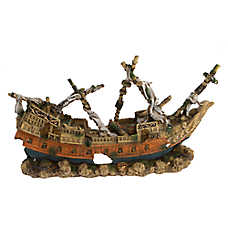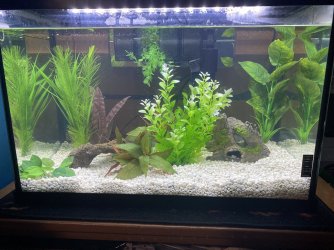I am on round 4 of my 75 gallon tank for cycling. Am getting very frustrated, particularly the loss of life. It always seems to be our favorite Betta's that die.
Something has to be preventing nitrifying bacteria from growing in my set-up, likely actively killing it.
One thing that I discovered while disassembling the last set-up is a leak in the Aqueon Quietflow 400 cannister filter. The inlet side shut off valve that attaches to the cannister was leaking and was likely sucking air directly into the filter when running. I have a new one coming from Aqueon, so this should fix this problem.
Would the air infiltration into the filter cause the nitrifying bacteria to not grow?
My last set-up included a reverse flow set under gravel filter with 2 inches of
Imagitarium River Rock Shallow Creek Aquarium Gravel with the reverse flow coming from an
Aqueon QuietFlow 155/400 Canister Filter through 4 tubes. Aeration came from 2x
Tetra Whisper AP150 aquarium Air Pump, For Deep Water Applications through
MY MIRONEY 9.84" Air Stone Bar Nano Micro Bubble Diffuser White Plastic Casing Bubble Air Stone for Aquarium Fish Tank Pack of 2. The Cannister filter has the rough filter included with the filter followed by 1 full gallon of
Seachem Matrix, 4 L / 1 gal. with a more fine filter cut from
AQUANEAT Aquarium Bio Sponge Filter Media Pad Open Cell Foam Cut-to-fit Matten Filter Fish Tank Sump Divider 17.7" x 17" x 2" as the last internal filter. Total outlets for the filter were 6, 4 went through the under gravel filter and 2 went through the polishing units, one with carbon and one with filter floss only, although for a while I had a filter floss filled with crushed coral to raise the PH when i was running CO2, which I stopped doing as I thought it might be interfering with the nitrifying bacteria.
Here is a picture of my last attempt to get a healthy aquarium going. This set-up has been running since January and seems to have never built up any nitrifying bacteria despite using quick start live nitrifying bacteria... The arrows indicate the direction of water flow. Will ammonia kill amazon sword plants as these plants do not seem to last long... See the browning leaves in the floating plants in image below. All our snails died as well. 3 young clown plecos just simply disappeared with no body or skeleton to be found.
Filter media and the location of leak. Unless someone has a better media plan, I plan to use this again, minus the leaking valve. The bottom half of the lower tray is coarse foam filter, half seachem matrix biological filter, the middle tray is all seachem matrix biological filter, the top tray bottom half is seachem biological filter and the top half is a finer foam filter material.
Tap water quality is as follows:
16 in 1 test strip unless otherwise specified. mg/L unless otherwise specified. Alternates are API liquid, Dr meter Ph, Salifert Carbonate, Milliard 7 in 1
PH (16 in 1) 6.7 (Milliard) 6.4-6.8 (Dr Meter) 9.06 (API) 6.4-6.8 (Dr. meter was just calibrated, so not sure why it is so far off.)
Ammonia (API) did not test... gah!
Nitrite below 1 very light (milliard) 0
Nitrate below 10 very light (milliard) 0
hardness general 25-50 hard to tell
chlorine total 0-0.5
chlorine fee 0-0.5 (milliard) 0-0.5
bromine 0-1
iron 0
chromium 0-2
lead 0-20 weird? Is very light so probably less than 10
copper 0
mercury 0
fluoride very hard to read but between 0 and 50?
carbonate root 0 (Salifert) 0.6-1.2 changed very fast... (milliard) 0-40
total alkalinity 0 (milliard) 0-40
We use
API STRESS COAT Aquarium Water Conditioner 32-Ounce Bottle to treat the water when doing water changes. For the 75 gallon aquarium after cleaning the substrate the aquarium is treated with the conditioner and then water is added at the correct temperature through
Aqueon Aquarium Water Changer - 50 feet connected to our bathroom shower hose.
Once we set up the aquarium, things work fine for a few weeks and then the ammonia rises and will not go down. It requires large water changes (40%) to keep it below 1ppm and short of 90% water changes, it stays above safe level (0.25ppm). We do water changes and use a gravel cleaner to get detritus out of the aquarium and even went to a single feeding per day for 6 weeks to reduce the load on the nitrifying bacteria system. We pull the ship out in order to get detritus under it as well. When we tore down the aquarium recently, there was little detritus under the under gravel filter, so that does not appear to be the problem.
I have used this,
Fritz Aquatics 80223 FritzZyme 7 Nitrifying Bacteria for Fresh Water Aquariums, 1-Gallon), since December through middle of March with every water change, using the recommended doses at first and finally just dumping what was left which was about a quart at the end. It never seemed to work to lower ammonia.
Then I ordered this,
API QUICK START Freshwater and Saltwater Aquarium Nitrifying Bacteria 32-Ounce Bottle, thinking that maybe the FritzZyme was not very good quality, the middle of March and used the whole thing and the Ammonia still did not go down a smidgen over a period of a week.
The FritzZyme is a cloudy pinkish color with stringy filaments that makes it seem as though there is something in it, the API Quick Start on the other hand is perfectly clear like water making me wonder if it was real?
I am in the process of rebuilding my 75 gallon aquarium. It is currently torn down to just having gravel at the bottom and no water. So, I am looking for suggestions to get this aquarium up and running and healthy.
Items available for the rebuild... Open to buying new stuff if it will be helpful.




